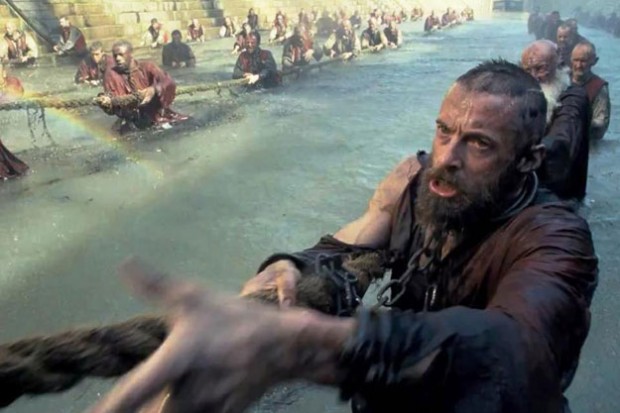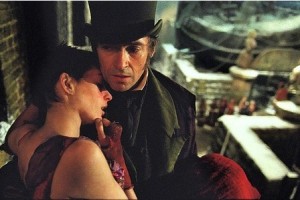You have no items in your cart. Want to get some nice things?
Go shopping
The time was ripe for a new take on the story: in its relatively short twenty-seven year lifespan, Les Misérables has become a staple food for musical theatre. Since it debuted at London’s Barbican in 1985, everybody from amateur drama clubs to bankrolled Broadway troupes have gotten in on the act. So what did film director Tom Hooper and his team have to bring to this much-played piece? The answer: the magic of modern-day cinema, which gives it the epic treatment it deserves.
“Big” is one of the major themes of Hooper’s film adaption, from the very first shot until the credits start to roll. The action begins with a throng of scraggly-looking men chanting a rendition of the show’s signature piece “Look Down” and struggling to haul a Titanic-sized sailing ship off swirling, pitching waters. There, as part of the chorus, we spot an equally dishevelled Hugh Jackman – our hero Jean Valjean, who has been imprisoned for pinching a loaf of bread. It’s an impressive sequence, one that stands as a reminder that this ain’t no community arts, low-budget production. No, no – this is blockbuster territory; the realm of films like Ben-Hur, Braveheart and the Lord of the Rings franchise.
The artistry that went into the creative effects as well as the costumes, makeup and set work in this production gives revolutionary France a grim atmosphere – one that does justice to Victor Hugo’s 1862 novel of love, poverty and revolution. The visual enhancements are so seamlessly executed that after seeing this film, the aforementioned 800-foot vessel now seems an immovable element of the show (figuratively, in this case). The similarly spectacular tableaux, such as in Javert’s suicide scene, stand out from the rest of the film, with visuals that actually make you wonder how anyone could’ve staged this show before CGI saw the light of day.
As for photography, the novel camerawork gives Les Mis an intimacy that one would not get squinting through theatre binoculars. Much has been made of the fact that Hooper had his actors sing live before the camera, guided by orchestra music piped into tiny earpieces. This choice inevitably affected shooting style, necessitating fewer cuts and longer shots. Many frames are held for more than half a minute, some for an entire song; the focus searches in, out, and rests steadily on an actor’s face. This can make many viewers who are accustomed to the filmic conventions of quick transitions, pans and varied perspectives, a bit antsy. But the effect is great for building a closer relationship with the actors and music, highlighting the complex emotions between them.

There is generally something disconcerting about famous people doing things other than what we know them to do. We tend to react with some concern when, say, socialites take to writing books or film stars foray into politics. But for me, there was nothing strange about seeing Anne Hathaway of The Devil Wears Prada fame belt out Fantine’s soprano and Hugh Jackman, widely recognised as X-Men’s Wolverine, sing tenor. Nothing at all. These two actors, handpicked for their choral talents, seem to slip effortlessly into their new roles as vocalists – and I’d wager we’ll hear more from them in such roles in future. It is nice to know, however, that some things are more familiar: in his performance of the brilliant comic lout Thénardier, there is a hint of Borat in Sacha Baron Cohen’s intermittent French brogue.
All pomp and production value aside, it’s worth considering how true this film is to its precursor, Hugo’s thousand-plus page novel. “[The book] was an angry tirade against social injustice, against unacceptable poverty, and sadly . . . we’re still navigating these issues and they remain as timely as ever,” said Hooper in a recent interview. This film is built to be a monument to Hugo’s project – one-hundred and fifty years later after its writing – at a time when we have witnessed banks siphoning money out of the blue collar worker’s pension fund and children going hungry before school. In the present context, Hugo’s story still resonates, which is why people will likely turn out in their numbers for this film, even as fears of a triple-dip recession loom. What great irony that the film’s multi-million dollar budget allows it to portray the scourge of poverty so poignantly.
Les Misérables opened to great anticipation in the UK last week, already basking in the warmth of glowing reviews from around the world. The film is a visual and musical epic, a feast for the senses that does the stage show proud. The only negative thing that might be said about the film’s impact: audiences may never again be able to see the real, live, flesh-and-bone stage show without asking, “where’s the monstrous sailing ship? The hundred-strong chorus? The spectacular scenery? And where is Russell Crowe?” Hooper’s team have set a steep precedent, both for the world-renowned musical and for the Hollywood film. If they are looking down, it’s only because they’re at such a height.
Les Misérables is currently screening in UK cinemas nationwide.

About Sandra Smiley
Sandra spends her days working in PR and moonlights as a feature writer and blogger. You can follow her on @sandraqsmiley.





My glee club colours coming through in my review of the amazing Les Mis https://t.co/llaUNkHI via @LitroMagazine
Loved the book… Sure to love the movie… Hugh jackman n russel Crowe in one movie!!!! Beat that!!M